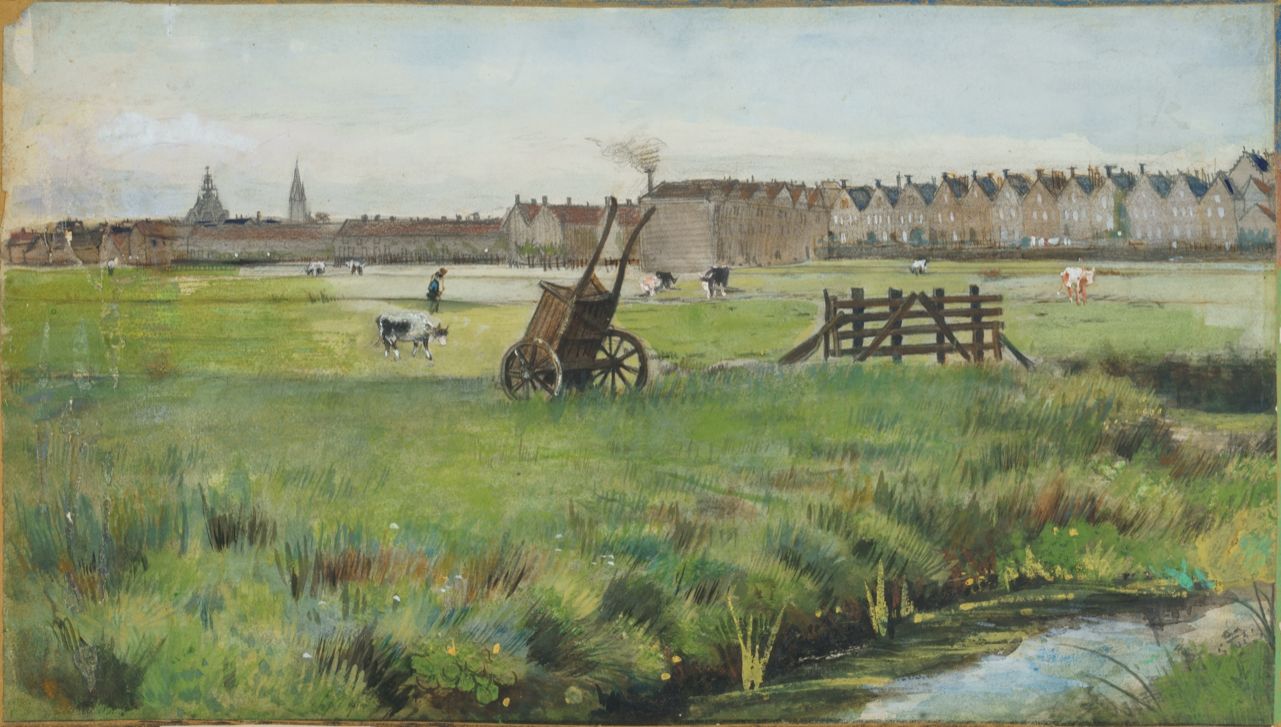Exclusive! Van Gogh’s colorful landscape surfaces are found in an attic in Japan.
Saitama|
In the New Church and St Jacob’s Church (July 1882), Van Gogh’s Meadow was deposited at the Museum of Modern Art, Saitama, from the collection of Marunuma Art Park.

Van Gogh’s Meadow, in the Background the New Church and St Jacob’s Church (July 1882) Courtesy of the Collection of Marunuma Art Park, deposited at the Museum of Modern Art, Saitama
To everyone’s surprise, a Japanese collector bought Vincent Van Gogh’s watercolor showing the outskirts of The Hague in the Netherlands. It has gone on loan to Saitama’s Museum of Modern Art, north of Tokyo. This has been showcased only once in 1903 and as a black-and-white photograph. Now the Meadow, in the Background the New Church and St Jacob’s Church in color is being reproduced.
The color image is one of Van Gogh’s most delicate early watercolors created in July 1882. The painting comprises fields with cows, the archetypal Dutch landscape with homes all lined up in a row with r a smoking factory chimney in the middle. You will also find in the far left the tower of the Nieuwe Kirk with that of St Jacob slightly to the right.
Van Gogh’s View of The Hague with the New Church (January 1882) Private collection
Vincent also painted a part of Japan near Schenkweg, a road just to the east of The Hague. It is believed that Vincent could see a view over meadows with cows from his cramped room that can be seen in the painting called the Carpenter’s Yard and Laundry.
Van Gogh’s Carpenter’s Yard and Laundry (May 1882) Courtesy of the Kröller-Müller Museum, Otterlo
It is believed that the survival of watercolor now in Japan has an interesting story, and it was a part of a large batch of Van Gogh’s early works.Vincent left behind the painting that he had brought from his stay in the Hague when he moved to his parents’ village of Nuenen in 1883. He kept it in a wooden crate and then left it there only when he moved from there two years later. In this crate, he also had reproductions of works by other artists which he admired.In 1886, when Vincent’s mother moved to the Dutch city of Breda, she brought the wooden crate along which Vincent had left behind. She had no place to store in her new house, and hence she kept those paintings with a local carpenter, Adrianus Schrauwen. Then these paintings were found in the crate marked in an attic.
Vincent addressed the crate as talking junk. It was found when many years later Schrauwen opened the crate, and he found folders with drawings, watercolors, and reproductions. Then in 1903, he sold some of his kitchen utensils and Vincent’s possessions for about four British shillings. A second-hand furniture dealer called these things was purchased by Johannes Couvreur, who initially stored the crate in his cellar. He later recalled it and sold the paintings and drawings in the market for a few pennies. Kees Mouwen, who ran a clothing shop, purchased it. However, he also sold Van Gogh’s works to the Rotterdam art dealer Margareta Oldenzeel, who finally understood its value and importance.
1903 exhibition-Oldenzeel’s advertisement, Het Vaderland.
Oldenzeel in 1903 held three exhibitions of Van Gogh’s work. One of them was called the Meadow, in the Background the New Church and St Jacob’s Church. You will not believe it, but the watercolor was sold for 105 florins (9 British pounds). It was then passed to the Dutch collectors in the 20th century. They were called Eduard van Biema, Felix Hirschel, and P. Verschure.
Then finally in last September, a Japanese collector, who is believed to be Katsushige Susaki, the director of Marunuma Art Park got them. Martin Bailey is a well-known and leading Van Gogh specialist and investigative reporter for The Art Newspaper. Bailey has held Van Gogh exhibitions at the Barbican Art Gallery and Compton Verney/National Gallery of Scotland.He was also the co-curator of Tate Britain’s The EY Exhibition: Van Gogh and Britain. He is also the author of many bestselling books, including The Sunflowers Are Mine: The Story of Van Gogh’s Masterpiece (Frances Lincoln 2013, available in the UK and US), Studio of the South: Van Gogh in Provence (Frances Lincoln 2016, available in the UK and the US) and Starry Night: Van Gogh at the Asylum (White Lion Publishing 2018, available in the UK and US ).
Bailey’s Living with Vincent van Gogh: The Homes & Landscapes that Shaped the Artist (White Lion Publishing 2019, available in the UK and US ) showcases Vincent’s life.
